Just some 30 miles from Palm Springs, on the southeastern edge of the Coachella Valley desert, Thermal is the future home of the 118-acre private, members-only Thermal Beach Club (TBC). The developers promise over 300 luxury homes with a dazzling array of amenities; the planned centerpiece is a 20-plus-acre artificial lagoon with a 3.8-acre surf pool offering waves up to seven feet high. According to an early version of the website, club memberships will start at $175,000 a year. (TBC’s developers did not respond to multiple emails asking for comment.)
That price tag makes it clear that the club is not meant for locals. Thermal, an unincorporated desert community, currently has a median family income of $32,340. Most of its residents are Latino; many are farmworkers. The community lacks much of the basic infrastructure that serves the western Coachella Valley, including public water service—leaving residents dependent on aging private wells for drinking water.
Just a few blocks away from the TBC site is the 60-acre Oasis Mobile Home Park. A dilapidated development designed for some 1,500 people in about 300 mobile homes, Oasis has been plagued for decades by a lack of clean drinking water. The park owners have been cited numerous times by the Environmental Protection Agency for providing tap water contaminated with high levels of arsenic, and last year, the US Department of Justice filed a lawsuit against them for violating the Safe Drinking Water Act. Some residents have received assistance to relocate, but many of those who remain rely on weekly state-funded deliveries of bottled water and on the local high school for showers.
Stephanie Ambriz, a 28-year-old special-needs teacher who grew up near Thermal, recalls feeling “a lot of rage” back in early 2020 when she first heard about plans for the TBC development. Ambriz and other locals organized a campaign against the proposed club, which she says the community doesn’t want and won’t be able to access. What residents do want, she tells me, is drinkable water, affordable housing, and clean air—and to have their concerns heard and taken seriously by local officials.
Despite the grassroots pushback, which twice led to delays to allow more time for community feedback, the Riverside County Board of Supervisors unanimously approved the plans for the club in October 2020. It was, Ambriz says, “a shock to see that the county is willing to approve these luxurious developments when they’ve ignored community members” for decades. (A Riverside County representative did not respond to specific questions about TBC.)
The desert may seem like a counterintuitive place to build a water-intensive surf pool, but the Coachella Valley is actually “the very best place to possibly put one of these things,” argues Doug Sheres, the developer behind DSRT Surf, another private pool planned for the area. It is “close to the largest [and] wealthiest surf population in the world,” he says, featuring “360 days a year of surfable weather” and mountain and lake views in “a beautiful resort setting” served by “a very robust aquifer.”
In addition to the two planned projects, the Palm Springs Surf Club (PSSC) has already opened locally. The trifecta is turning the Coachella Valley into “the North Shore of wave pools,” as one aficionado described it to Surfer magazine.
The effect is an acute cognitive dissonance—one that I experienced after spending a few recent days crisscrossing the valley and trying out the waves at PSSC. But as odd as this setting may seem, an analysis by MIT Technology Review reveals that the Coachella Valley is not the exception. Of an estimated 162 surf pools that have been built or announced around the world, as tracked by the industry publication Wave Pool Magazine, 54 are in areas considered by the nonprofit World Resources Institute (WRI) to face high or extremely high water stress, meaning that they regularly use a large portion of their available surface water supply annually. Regions in the “extremely high” category consume 80% or more of their water, while those in the “high” category use 40% to 80% of their supply. (Not all of Wave Pool Magazine’s listed pools will be built, but the publication tracks all projects that have been announced. Some have closed and over 60 are currently operational.)
Zoom in on the US and nearly half are in places with high or extremely high water stress, roughly 16 in areas served by the severely drought-stricken Colorado River. The greater Palm Springs area falls under the highest category of water stress, according to Samantha Kuzma, a WRI researcher (though she notes that WRI’s data on surface water does not reflect all water sources, including an area’s access to aquifers, or its water management plan).
Now, as TBC’s surf pool and other planned facilities move forward and contribute to what’s becoming a multibillion-dollar industry with proposed sites on every continent except Antarctica, inland waves are increasingly becoming a flash point for surfers, developers, and local communities. There are at least 29 organized movements in opposition to surf clubs around the world, according to an ongoing survey from a coalition called No to the Surf Park in Canéjan, which includes 35 organizations opposing a park in Bordeaux, France.
While the specifics vary widely, at the core of all these fights is a question that’s also at the heart of the sport: What is the cost of finding, or now creating, the perfect wave—and who will have to bear it?
Though wave pools have been around since the late 1800s, the first artificial surfing wave was built in 1969, and also in the desert—at Big Surf in Tempe, Arizona. But at that pool and its early successors, surfing was secondary; people who went to those parks were more interested in splashing around, and surfers themselves weren’t too excited by what they had to offer. The manufactured waves were too small and too soft, without the power, shape, or feel of the real thing.
The tide really turned in 2015, when Kelly Slater, widely considered to be the greatest professional surfer of all time, was filmed riding a six-foot-tall, 50-second barreling wave. As the viral video showed, he was not in the wild but atop a wave generated in a pool in California’s Central Valley, some 100 miles from the coast.
Waves of that height, shape, and duration are a rarity even in the ocean, but “Kelly’s wave,” as it became known, showed that “you can make waves in the pool that are as good as or better than what you get in the ocean,” recalls Sheres, the developer whose company, Beach Street Development, is building multiple surf pools around the country, including DSRT Surf. “That got a lot of folks excited—myself included.”
In the ocean, a complex combination of factors—including wind direction, tide, and the shape and features of the seafloor—is required to generate a surfable wave. Re-creating them in an artificial environment required years of modeling, precise calculations, and simulations.
Surf Ranch, Slater’s project in the Central Valley, built a mechanical system in which a 300-ton hydrofoil—which resembles a gigantic metal fin—is pulled along the length of a pool 700 yards long and 70 yards wide by a mechanical device the size of several train cars running on a track. The bottom of the pool is precisely contoured to mimic reefs and other features of the ocean floor; as the water hits those features, its movement creates the 50-second-long barreling wave. Once the foil reaches one end of the pool, it runs backwards, creating another wave that breaks in the opposite direction.
While the result is impressive, the system is slow, producing just one wave every three to four minutes.
Around the same time Slater’s team was tinkering with his wave, other companies were developing their own technologies to produce multiple waves, and to do so more rapidly and efficiently—key factors in commercial viability.
Fundamentally, all the systems create waves by displacing water, but depending on the technology deployed, there are differences in the necessary pool size, the project’s water and energy requirements, the level of customization that’s possible, and the feel of the wave.
Thomas Lochtefeld is a pioneer in the field and the CEO of Surf Loch, which powers PSSC’s waves. Surf Loch uses pneumatic technology, in which compressed air cycles water through chambers the size of bathroom stalls and lets operators create countless wave patterns.
One demo pool in Australia uses what looks like a giant mechanical doughnut that sends out waves the way a pebble dropped in water sends out ripples. Another proposed plan uses a design that spins out waves from a circular fan—a system that is mobile and can be placed in existing bodies of water.
Of the two most popular techniques in commercial use, one relies on modular paddles attached to a pier that runs across a pool, which move in precise ways to generate waves. The other is pneumatic technology, which uses compressed air to push water through chambers the size of bathroom stalls, called caissons; the caissons pull in water and then push it back out into the pool. By choosing which modular paddles or caissons move first against the different pool bottoms, and with how much force at a time, operators can create a range of wave patterns.
Regardless of the technique used, the design and engineering of most modern wave pools are first planned out on a computer. Waves are precisely calculated, designed, simulated, and finally tested in the pool with real surfers before they are set as options on a “wave menu” in proprietary software that surf-pool technologists say offers a theoretically endless number and variety of waves.
On a Tuesday afternoon in early April, I am the lucky tester at the Palm Springs Surf Club, which uses pneumatic technology, as the team tries out a shoulder-high right-breaking wave.
I have the pool to myself as the club prepares to reopen; it had closed to rebuild its concrete “beach” just 10 days after its initial launch because the original beach had not been designed to withstand the force of the larger waves that Surf Loch, the club’s wave technology provider, had added to the menu at the last minute. (Weeks after reopening in April, the surf pool closed again as the result of “a third-party equipment supplier’s failure,” according to Thomas Lochtefeld, Surf Loch’s CEO.)
I paddle out and, at staffers’ instructions, take my position a few feet away from the third caisson from the right, which they say is the ideal spot to catch the wave on the shoulder—meaning the unbroken part of the swell closest to its peak.
The entire experience is surreal: waves that feel like the ocean in an environment that is anything but.
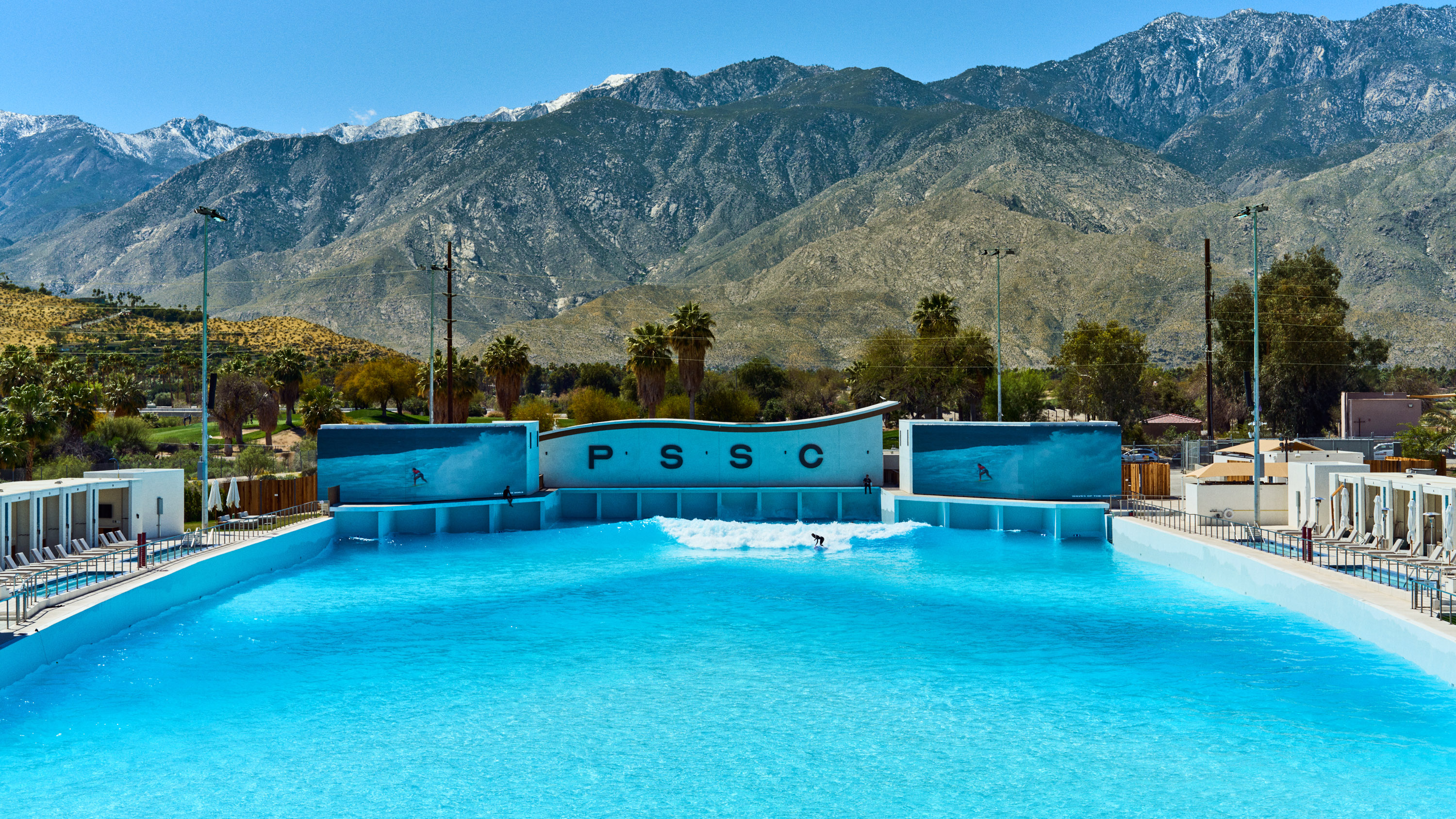
SPENCER LOWELL
In some ways, these pneumatic waves are better than what I typically ride around Los Angeles—more powerful, more consistent, and (on this day, at least) uncrowded. But the edge of the pool and the control tower behind it are almost always in my line of sight. And behind me are the PSSC employees (young men, incredible surfers, who keep an eye on my safety and provide much-needed tips) and then, behind them, the snow-capped San Jacinto Mountains. At the far end of the pool, behind the recently rebuilt concrete beach, is a restaurant patio full of diners who I can’t help but imagine are judging my every move. Still, for the few glorious seconds that I ride each wave, I am in the same flow state I experience in the ocean itself.
Then I fall and sheepishly paddle back to PSSC’s encouraging surfer-employees to restart the whole process. I would be having a lot of fun—if I could just forget my self-consciousness, and the jarring feeling that I shouldn’t be riding waves in the middle of the desert at all.
Though long inhabited by Cahuilla Indians, the Coachella Valley was sparsely populated until 1876, when the Southern Pacific Railroad added a new line out to the middle of the arid expanse. Shortly after, the first non-native settlers came to the valley and realized that its artesian wells, which flow naturally without the need to be pumped, provided ideal conditions for farming.
Agricultural production exploded, and by the early 1900s, these once freely producing wells were putting out significantly less, leading residents to look for alternative water sources. In 1918, they created the Coachella Valley Water District (CVWD) to import water from the Colorado River via a series of canals. This water was used to supply the region’s farms and recharge the Coachella Aquifer, the region’s main source of drinking water.
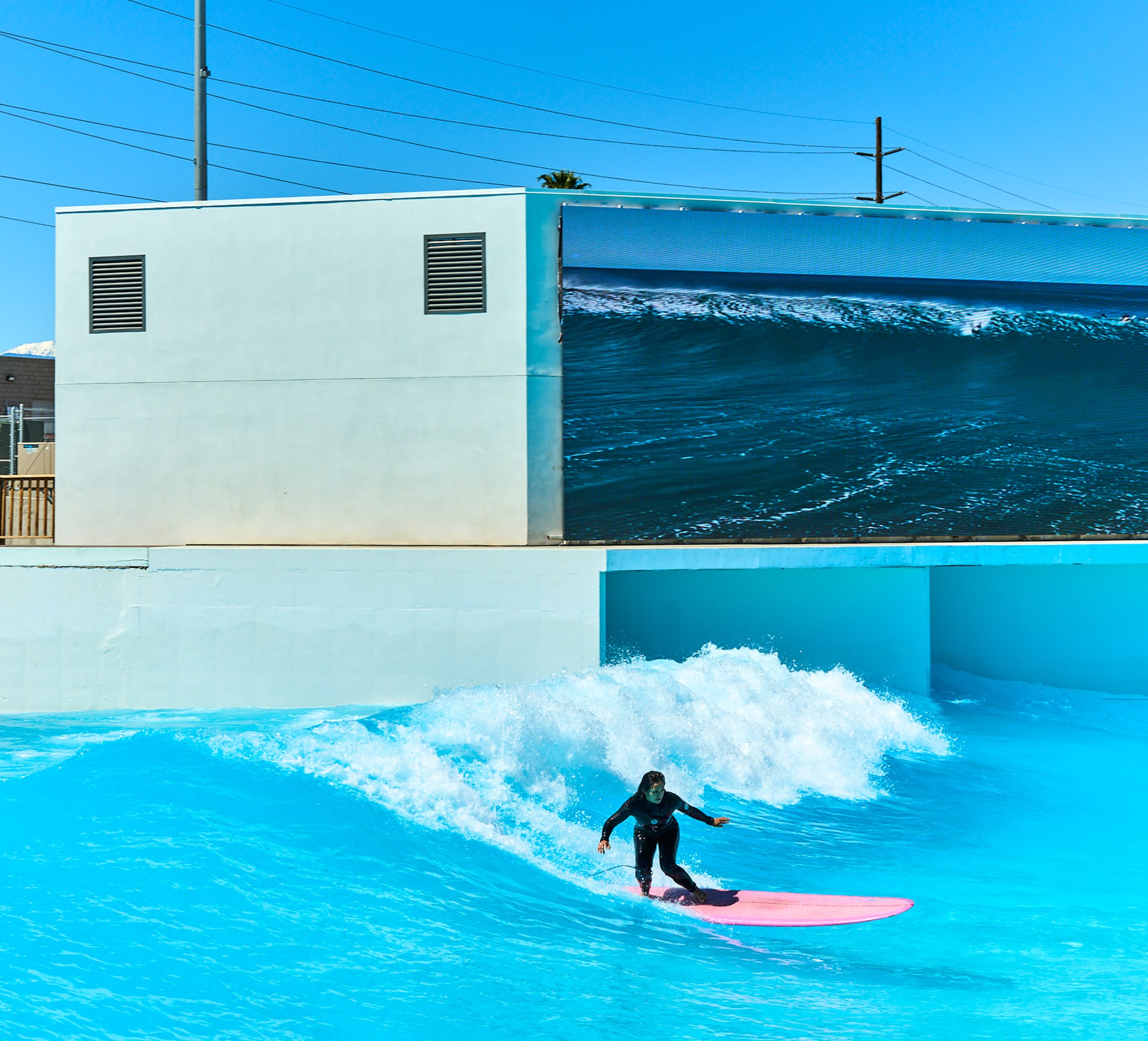
SPENCER LOWELL
The water imports continue to this day—though the seven states that draw on the river are currently renegotiating their water rights amid a decades-long megadrought in the region.
The imported water, along with CVWD’s water management plan, has allowed Coachella’s aquifer to maintain relatively steady levels “going back to 1970, even though most development and population has occurred since,” Scott Burritt, a CVWD spokesperson, told MIT Technology Review in an email.
This has sustained not only agriculture but also tourism in the valley, most notably its world-class—and water-intensive—golf courses. In 2020, the 120 golf courses under the jurisdiction of the CVWD consumed 105,000 acre-feet of water per year (AFY); that’s an average of 875 AFY, or 285 million gallons per year per course.
Surf pools’ proponents frequently point to the far larger amount of water golf courses consume to argue that opposing the pools on grounds of their water use is misguided.
PSSC, the first of the area’s three planned surf clubs to open, requires an estimated 3 million gallons per year to fill its pool; the proposed DSRT Surf holds 7 million gallons and estimates that it will use 24 million gallons per year, which includes maintenance and filtration, and accounts for evaporation. TBC’s planned 20-acre recreational lake, 3.8 acres of which will contain the surf pool, will use 51 million gallons per year, according to Riverside County documents. Unlike standard swimming pools, none of these pools need to be drained and refilled annually for maintenance, saving on potential water use. DSRT Surf also boasts about plans to offset its water use by replacing 1 million square feet of grass from an adjacent golf course with drought-tolerant plants.
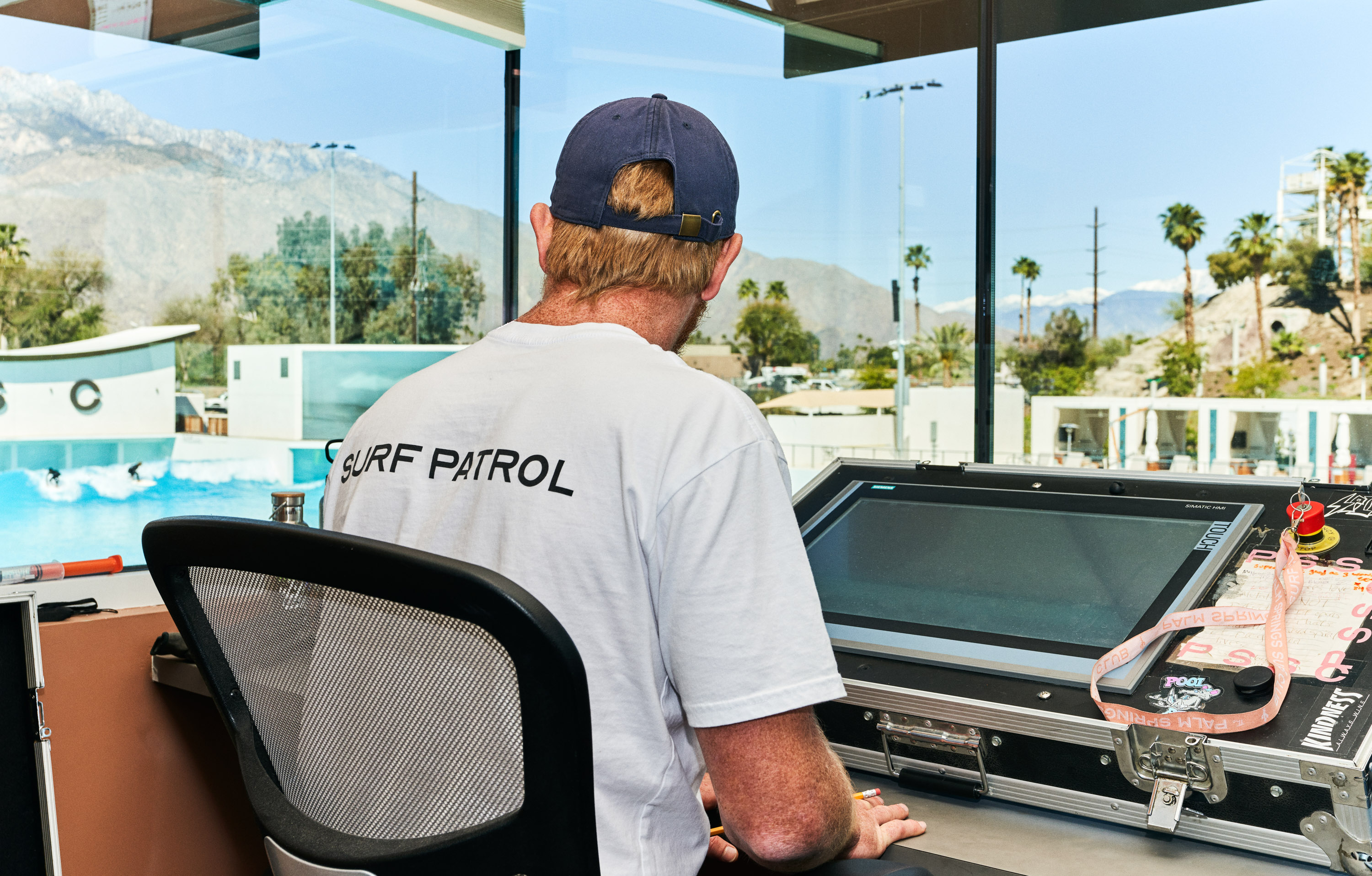
SPENCER LOWELL
With surf parks, “you can see the water,” says Jess Ponting, a cofounder of Surf Park Central, the main industry association, and Stoke, a nonprofit that aims to certify surf and ski resorts—and, now, surf pools—for sustainability. “Even though it’s a fraction of what a golf course is using, it’s right there in your face, so it looks bad.”
But even if it were just an issue of appearance, public perception is important when residents are being urged to reduce their water use, says Mehdi Nemati, an associate professor of environmental economics and policy at the University of California, Riverside. It’s hard to demand such efforts from people who see these pools and luxury developments being built around them, he says. “The questions come: Why do we conserve when there are golf courses or surfing … in the desert?”
(Burritt, the CVWD representative, notes that the water district “encourages all customers, not just residents, to use water responsibly” and adds that CVWD’s strategic plans project that there should be enough water to serve both the district’s golf courses and its surf pools.)
Locals opposing these projects, meanwhile, argue that developers are grossly underestimating their water use, and various engineering firms and some county officials have in fact offered projections that differ from the developers’ estimates. Opponents are specifically concerned about the effects of spray, evaporation, and other factors, which increase with higher temperatures, bigger waves, and larger pool sizes.
As a rough point of reference, Slater’s 14-acre wave pool in Lemoore, California, can lose up to 250,000 gallons of water per day to evaporation, according to Adam Fincham, the engineer who designed the technology. That’s roughly half an Olympic swimming pool.
More fundamentally, critics take issue with even debating whether surf clubs or golf courses are worse. “We push back against all of it,” says Ambriz, who organized opposition to TBC and argues that neither the pool nor an exclusive new golf course in Thermal benefits the local community. Comparing them, she says, obscures greater priorities, like the water needs of households.
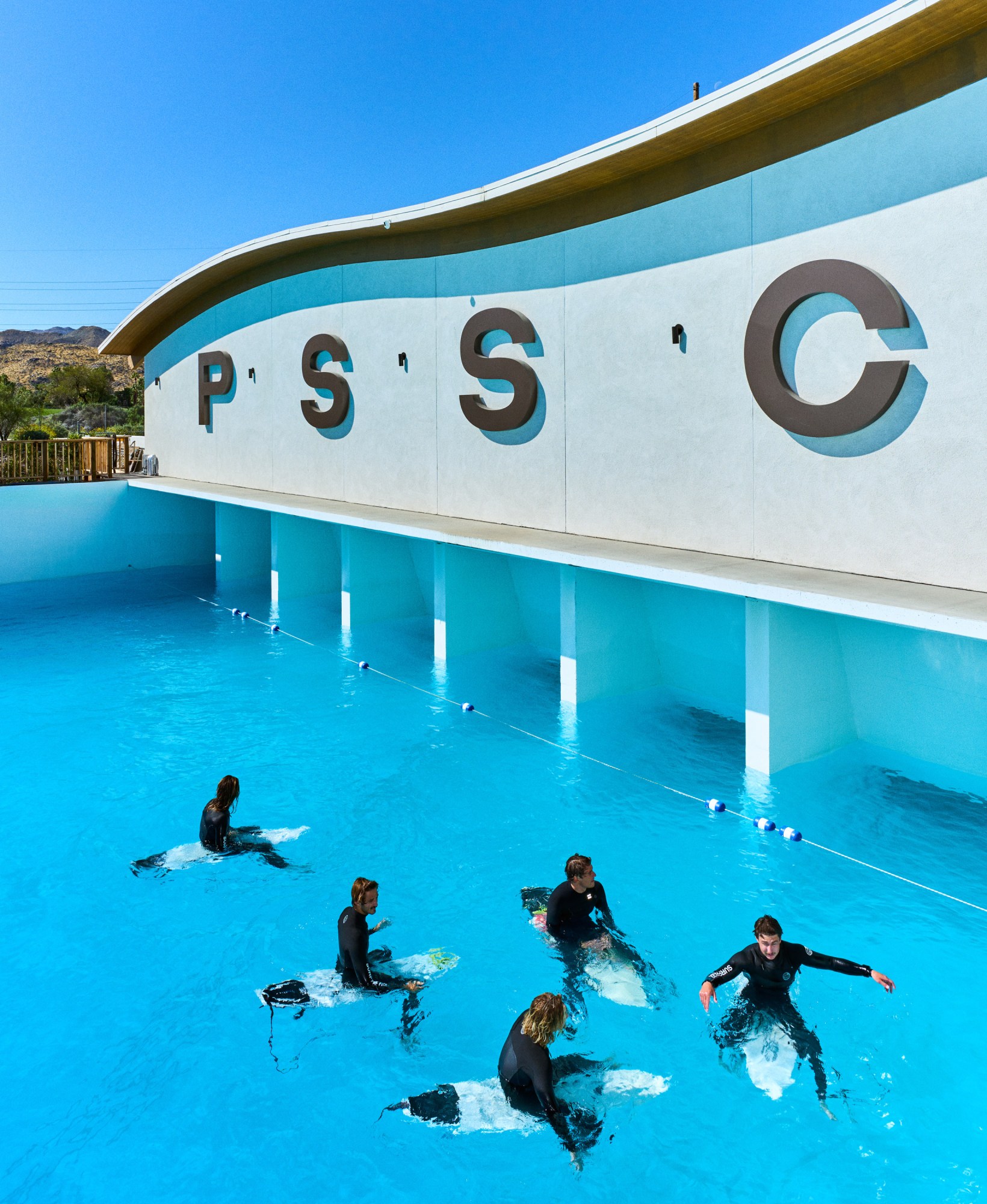
SPENCER LOWELL
The “primary beneficiary” of the area’s water, says Mark Johnson, who served as CVWD’s director of engineering from 2004 to 2016, “should be human consumption.”
Studies have shown that just one AFY, or nearly 326,000 gallons, is generally enough to support all household water needs of three California families every year. In Thermal, the gap between the demands of the surf pool and the needs of the community is even more stark: each year for the past three years, nearly 36,000 gallons of water have been delivered, in packages of 16-ounce plastic water bottles, to residents of the Oasis Mobile Home Park—some 108,000 gallons in all. Compare that with the 51 million gallons that will be used annually by TBC’s lake: it would be enough to provide drinking water to its neighbors at Oasis for the next 472 years.
Furthermore, as Nemati notes, “not all water is the same.” CVWD has provided incentives for golf courses to move toward recycled water and replace grass with less water-intensive landscaping. But while recycled water and even rainwater have been proposed as options for some surf pools elsewhere in the world, including France and Australia, this is unrealistic in Coachella, which receives just three to four inches of rain per year.
Instead, the Coachella Valley surf pools will depend on a mix of imported water and nonpotable well water from Coachella’s aquifer.
But any use of the aquifer worries Johnson. Further drawing down the water, especially in an underground aquifer, “can actually create water quality problems,” he says, by concentrating “naturally occurring minerals … like chromium and arsenic.” In other words, TBC could worsen the existing problem of arsenic contamination in local well water.
When I describe to Ponting MIT Technology Review’s analysis showing how many surf pools are being built in desert regions, he seems to concede it’s an issue. “If 50% of the surf parks in development are in water-stressed areas,” he says, “then the developers are not thinking about the right things.”
Before visiting the future site of Thermal Beach Club, I stopped in La Quinta, a wealthy town where, back in 2022, community opposition successfully stopped plans for a fourth pool planned for the Coachella Valley. This one was developed by the Kelly Slater Wave Company, which was acquired by the World Surf League in 2016.
Alena Callimanis, a longtime resident who was a member of the community group that helped defeat the project, says that for a year and a half, she and other volunteers often spent close to eight hours a day researching everything they could about surf pools—and how to fight them. “We knew nothing when we started,” she recalls. But the group learned quickly, poring over planning documents, consulting hydrologists, putting together presentations, providing comments at city council hearings, and even conducting their own citizen science experiments to test the developers’ assertions about the light and noise pollution the project could create. (After the council rejected the proposal for the surf club, the developers pivoted to previously approved plans for a golf course. Callimanis’s group also opposes the golf course, raising similar concerns about water use, but since plans have already been approved, she says, there is little they can do to fight back.)
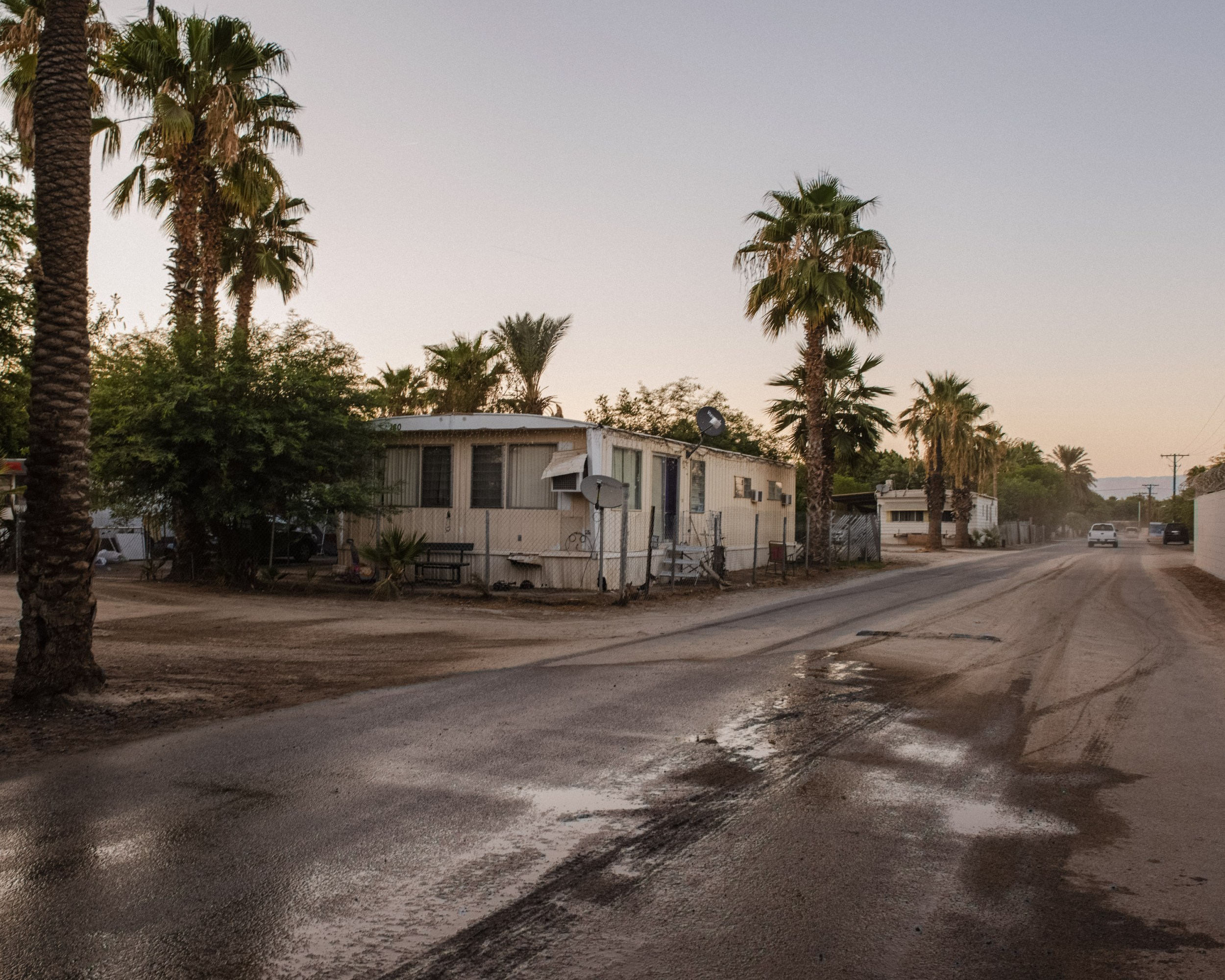
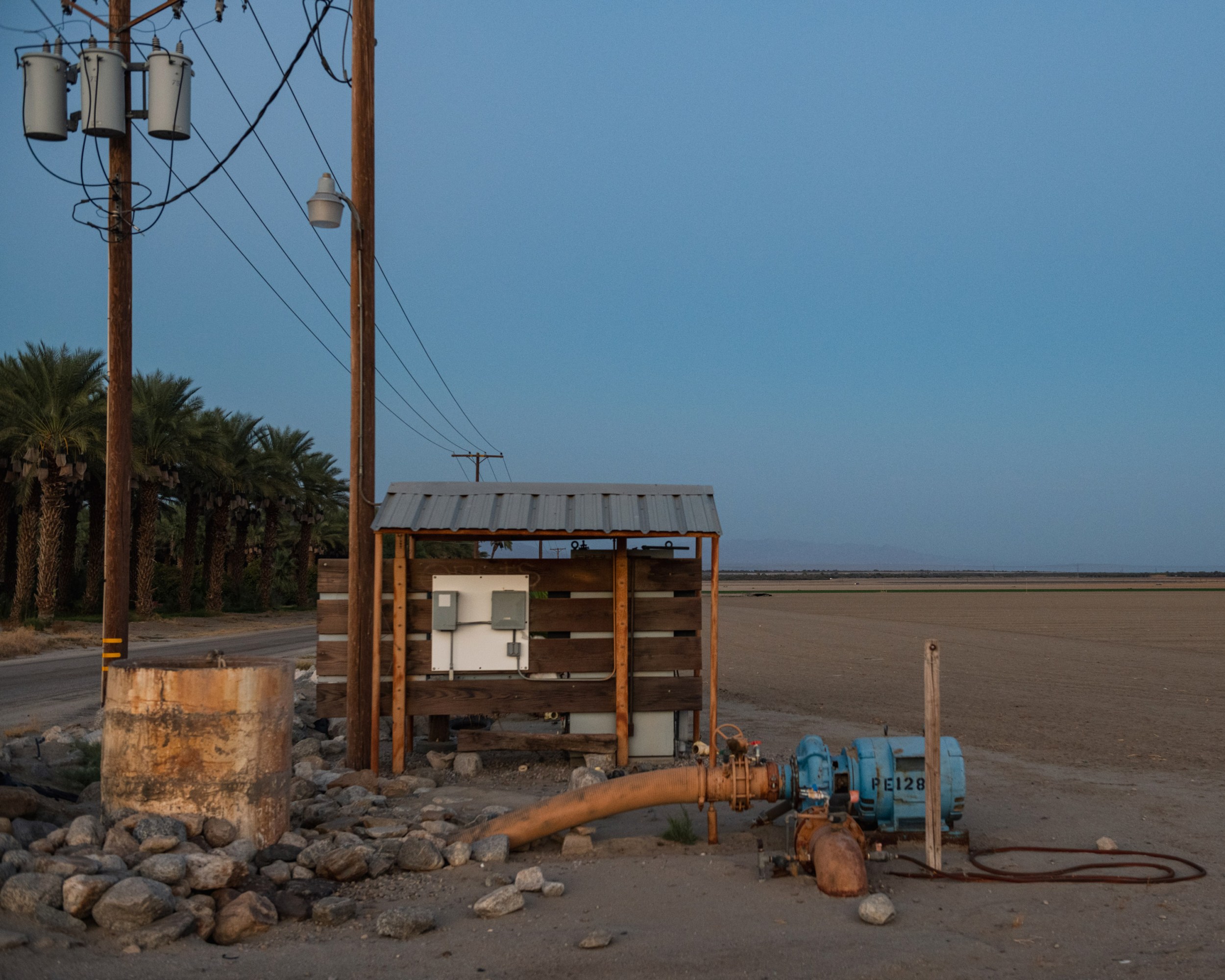
corner of farm fields in Thermal, California,
where irrigation water is imported from the
Colorado River.
It was a different story in Thermal, where three young activists juggled jobs and graduate programs as they tried to mobilize an under-resourced community. “Folks in Thermal lack housing, lack transportation, and they don’t have the ability to take a day off from work to drive up and provide public comment,” says Ambriz.
But the local pushback did lead to certain promises, including a community benefit payment of $2,300 per luxury housing unit, totaling $749,800. In the meeting approving the project, Riverside County supervisor Manuel Perez called this “unprecedented” and credited the efforts of Ambriz and her peers. (Ambriz remains unconvinced. “None of that has happened,” she says, and payments to the community don’t solve the underlying water issues that the project could exacerbate.)
That affluent La Quinta managed to keep a surf pool out of its community where working-class Thermal failed is even more jarring in light of industry rhetoric about how surf pools could democratize the sport. For Bryan Dickerson, the editor in chief of Wave Pool Magazine, the collective vision for the future is that instead of “the local YMCA … putting in a skate park, they put in a wave pool.” Other proponents, like Ponting, describe how wave pools can provide surf therapy or opportunities for underrepresented groups. A design firm in New York City, for example, has proposed to the city a plan for an indoor wave pool in a low-income, primarily black and Latino neighborhood in Queens—for $30 million.
For its part, PSSC cost an estimated $80 million to build. On top of a $40 general admission fee, a private session like the one I had would cost $3,500 to $5,000 per hour, while a public session would be at least $100 to $200, depending on the surfer’s skill level and the types of waves requested.
In my two days traversing the 45-mile Coachella Valley, I kept thinking about how this whole area was an artificial oasis made possible only by innovations that changed the very nature of the desert, from the railroad stop that spurred development to the irrigation canals and, later, the recharge basins that stopped the wells from running out.
In this transformed environment, I can see how the cognitive dissonance of surfing a desert wave begins to shrink, tempting us to believe that technology can once again override the reality of living (or simply playing) in the desert in a warming and drying world.
But the tension over surf pools shows that when it comes to how we use water, maybe there’s no collective “us” here at all.




